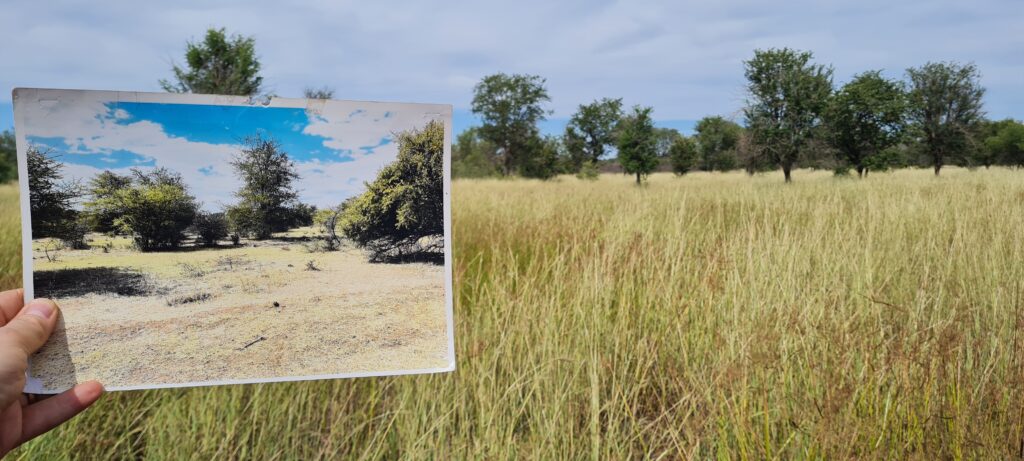May Your Grass Grow Tall and Your Rivers Run Deep!
Adaptive grazing is key to resilience in Zimbabwe and the world should pay attention.
This grassland in Matabeleland, about 30 km east of Victoria Falls in Zimbabwe, was restored in four years using one tool only: the community’s cattle. What you’re looking at is a range that is undergoing the worst drought the Zambia-Zimbabwe area have ever faced.
The community – they call themselves the Ndlhovu, or Elephant Community – decided to do something about their collapsing rangelands (the picture I’m holding up shows the same paddock 4 years ago).

They started by agreeing on what they all wanted, their so-called holistic context: briefly, water, grass, and peace.
They then put all their cattle into a communal herd and mob-grazed them adaptively. They bunch their cows really tightly together (for example with a solar-powered electric fence, which costs about $100 for 500 meters of tape, a solar panel, and a battery) until they’ve eaten circa 60 percent of the grass.
Why leave 40 percent of the grass? Well, that means that by the time the grass is fully regrown, its rootstock will not be fully depleted, and the plant will stay healthy. if you graze more, most of the nutrition in the rootstock will go to make leaves, leaving a very shallow root, and when the animals come back, they risk killing the plant.
They then move them on to the next small plot, typically after no more than a day. That manures the plot, mulches the 40 percent of grass that hasn’t been eaten as well as the unpalatable stuff, and pushes grass seeds into the soil (hooves).
Advanced managers of smaller national parks are using inducements – water, salt licks and molasses trails – to get wildlife away from degraded zones and keep them from coming back.
When the rains come, boom! The place explodes with growth. Rinse and repeat on your whole range, and don’t come back until the grass has fully regrown (if you aim for grass) or can cope with renewed grazing (if you want to boost beef productivity – or, as now, tide your animals over a bad drought).
It’s called adaptive because those decisions – how frequently to move the beasts, where to go next, what to aim for in the short, medium and long term etc. – are core to this management system. If you’re not a curious grower, forget it (or hire a head herder who is).
If you aim to restore land that’s been really nuked, night-kraal the cows tightly right on top of it – their hooves will break the crust, their manure will re-inject some much-needed microbiome into that soil, and there’ll be some undigested grass seeds in the manure to start things off.

And does that always mean cows? No. Advanced managers of smaller national parks are using inducements – water, salt licks and molasses trails – to get wildlife away from degraded zones and keep them from coming back. Well, most wildlife: elephants do what they want.
One final detail: ticks, which transmit disease, typically fall off an animal when they’re full of blood, digest it and wait for the next one to come along. If no animal comes by for months, they die of starvation. No more ticks when animals finally come back!
Let’s roll this out at scale, together with communities, and see our world’s grasslands thrive again!